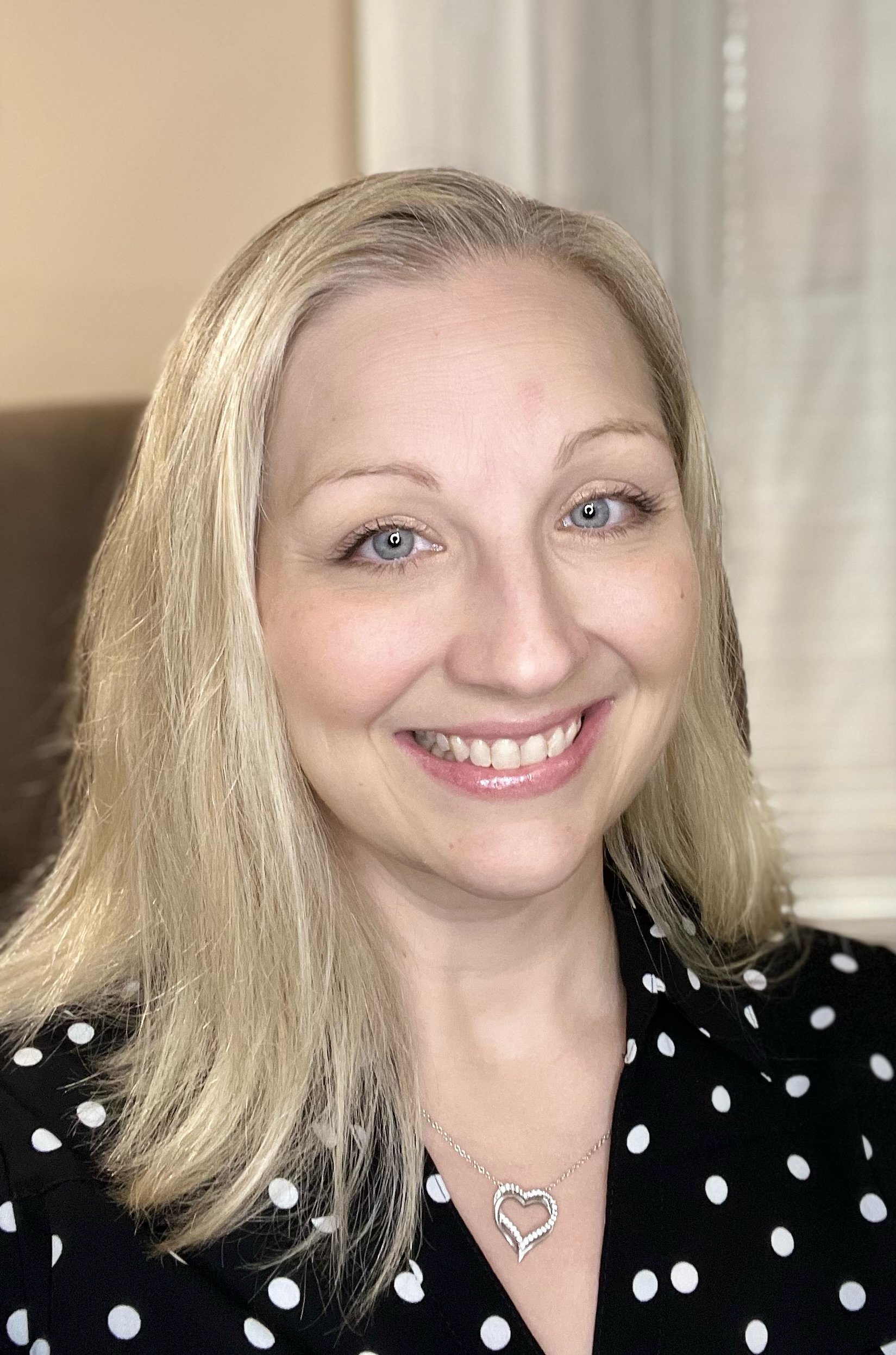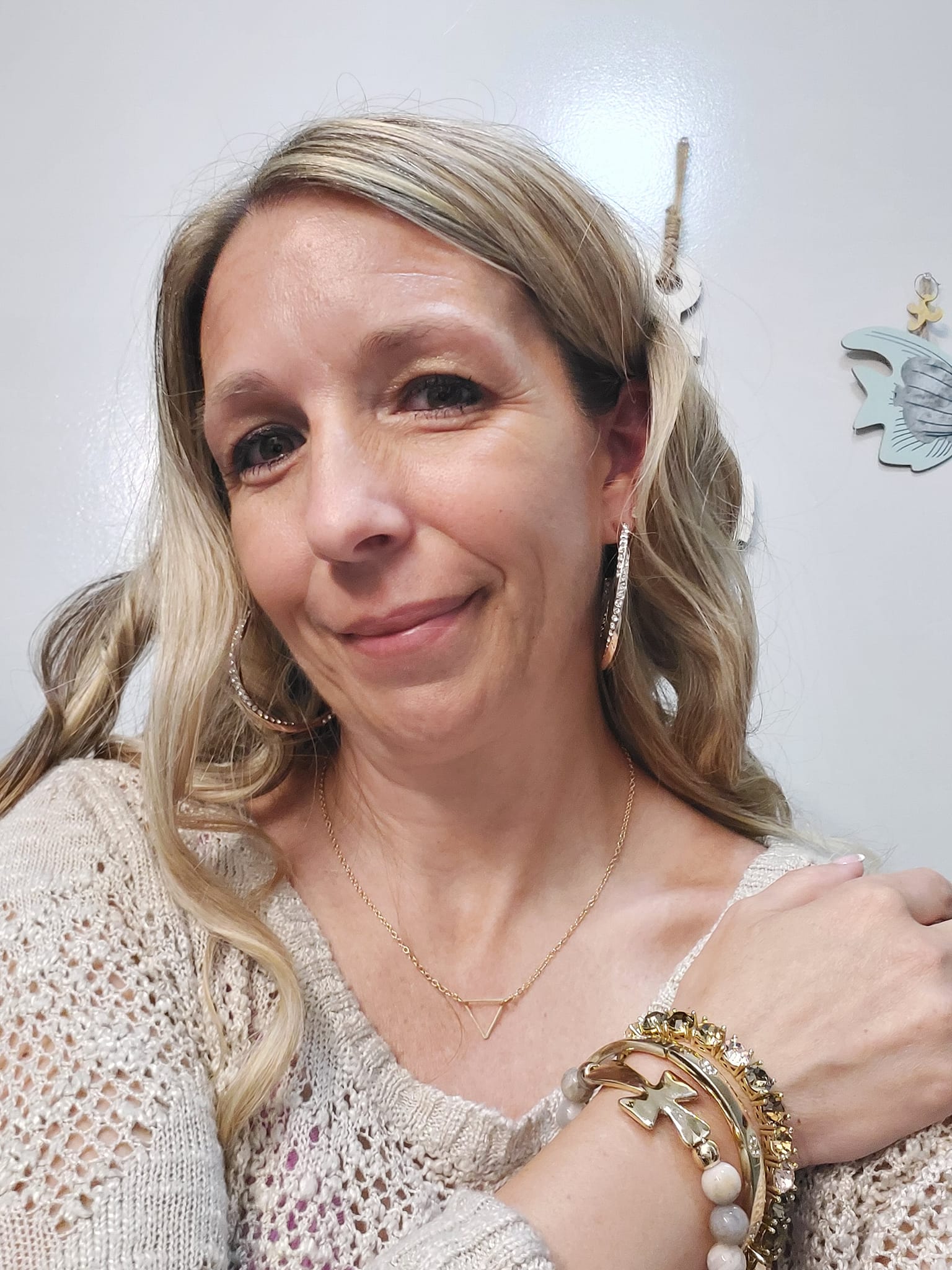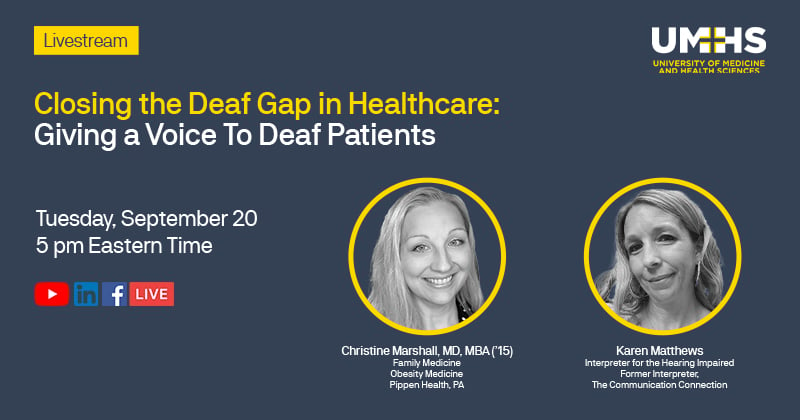Dr. Christine Marshall (née Fetterolf), UMHS 2015 grad, is a real-life CODA (Child of Deaf Adults). She grew up with deaf parents and advocated for them in every aspect of life, including healthcare. In honor of September being Deaf Awareness Month, Dr. Marshall and interpreter Karen Matthews will talk about treating deaf patients on the upcoming UMHS livestream "Closing the Deaf Gap: Giving a Voice to Deaf Patients” on Tuesday, September 20 at 5pm Eastern.
The UMHS Endeavour spoke to Dr. Marshall and Ms. Matthews about the challenges people who are deaf face when seeking medical care. UMHS is hosting "Closing the Deaf Gap in Healthcare: Giving a Voice to Deaf Patients” livestream on Tuesday, September 20 at 5pm Eastern so future doctors from UMHS can help patients who are deaf have better medical experiences.
 Dr. Christine Marshall is a 2015 UMHS graduate & will be a panelist on the UMHS livestream "Closing the Dead Gap: Giving a Voice to Deaf Patients" on Tuesday, September 20 at 5pm Eastern. Photo courtesy of Dr. Marshall.
Dr. Christine Marshall is a 2015 UMHS graduate & will be a panelist on the UMHS livestream "Closing the Dead Gap: Giving a Voice to Deaf Patients" on Tuesday, September 20 at 5pm Eastern. Photo courtesy of Dr. Marshall.
Dr. Christine Marshall
UMHS ENDEAVOUR: September is Deaf Awareness Month. We are hosting "Closing the Deaf Gap in Healthcare: Giving a Voice to Deaf Patients” livestream on Tuesday, September 20 at 5pm Eastern so future doctors from UMHS can help patients who are deaf have better medical experiences. The Oscar-winning movie CODA told the story of a young woman raised by deaf parents, and Dr. Marshall, you’ve sort of lived that story in real life. Tell us a little about your own experience with having deaf parents and helping them get better healthcare by advocating for them? What should people know about the challenges involved?
DR. CHRISTINE MARSHALL: That movie really hit home for me. As a CODA myself, I had similar experiences growing up and trying to help my parents navigate the world around us. I would make phone calls for them, interpret at restaurants, and sometimes go to their doctor’s appointments. Luckily, things have improved for patients with disabilities in healthcare so it’s easier to get interpreters but I would sometimes go with my parents to their appointments to make sure they understood and had their questions answered. Now, with patient portals and virtual interpreters, they are better able to navigate on their own but I will still push them to reach out and ask questions to their doctor if something doesn’t sound quite right or if they still have questions.”
Dr. Marshall, can you briefly tell us what you’ve been up to since graduating from UMHS? Can you tell us briefly about your residency, then working in family medicine in Pennsylvania and why you decided to go into weight management?
Since graduating from UMHS, I did residency in family medicine at Lehigh Valley Health Network in Allentown, PA. I absolutely loved my residency program. Everyone Iworked with was amazing and they supported my personal interests in the deaf community as well as weight management/obesity medicine. After residency, I stayed with Lehigh Valley, working in family medicine and got my board certification in obesity medicine. I’ve always had an interest in weight management and during residency I met another family medicine doctor that worked at our weight management center who inspired me to become board certified. I eventually left family medicine to join our weight management center and just recently left Lehigh Valley to pursue weight management via telemedicine.
You are no longer in family medicine but when you were, you said you had a few deaf patients in your practice you were able to communicate with. What would you say to a new doctor who gets a new deaf patient? Should they get an interpreter? And where does a doctor find a certified interpreter?
Absolutely get an interpreter and if you are able to schedule a new patient that needs an interpreter (not just deaf but any language) for more time, do it, A lot of times appointments get rushed or information is left out because there isn’t enough time to accurately convey everything through an interpreter especially if clarification is needed or there are connection issues with a virtual interpreter. If you are part of a hospital system, they usually have interpreter services available. Otherwise, there are usually local services or even virtual services you can find for an interpreter.
What advice and tips do you have for new doctors when they enter the exam room with a deaf patient for the first time?
When entering a room, I still knock and then enter slowly to give them a chance to see movement before I actually go in. If they don’t realize I’m there and they are facing me, I will wave to try to get their attention. If turned away, you can flash the light or lightly touch their shoulder. You still want to face them and talk to them rather than talk to the interpreter. The interpreter should also be next to you so the patient can still look at you and the interpreter at the same time.
You said in your article “Tips for Treating Deaf Patients” in Physicians Practice that family members and especially children should not be interpreters. Can you briefly explain why?
In the movie CODA, there is a perfect example of why you don’t want children interpreting for their parents! They may leave out important or private information that they may be embarrassed about or make up something that they do not fully understand.
You’ve said that not all deaf patients are lip readers. How should a doctor communicate best with a deaf patient who may not be a lip reader?
Lip reading should never be used as a sole form of communication because even the best lip readers can get confused since so many words look similar when spoken and can be confusing. An interpreter is still the best way to communicate with a deaf patient.
You’ve also noted that English is a second language for most deaf patients and a lot of medical terminology doesn’t exist in sign language. How do you explain a complicated medical term to a deaf patient?
I I will usually write the word down and then explain its meaning in simple terms. For example, explaining gastritis. Gastric means stomach and it means infection or inflammation. So, I will write down gastritis and explain it as a stomach infection having inflammation similar to when skin can be swollen and red if infected.
Can you talk briefly about working with deaf patients in emergency situations, like when they are waking up after surgery and how you handled communicating with them at the height of the COVID-19 pandemic by using a face shield instead of a mask?
Sign language uses the whole body and facial expressions, not just hands, so it’s important that the patient be able to see as much as possible. This means keeping bright lights out of their eyes as well as facing them when talking and avoiding anything blocking your face like a mask or computer. Clear masks [face shields] are helpful since they allow for reading lips and facial expressions.
Is there anything else you’d like to say about treating deaf patients in general, about your new practice or ways UMHS helped get you where you are today?
Don’t be afraid or embarrassed to ask how to best communicate with them.
 Karen Matthews is a professional deaf interpreter & will be a panelist on the UMHS livestream "Closing the Deaf Gap: Giving a Voice to Deaf Patients" on Tuesday, September 20, 2022 at 5pm Eastern.
Karen Matthews is a professional deaf interpreter & will be a panelist on the UMHS livestream "Closing the Deaf Gap: Giving a Voice to Deaf Patients" on Tuesday, September 20, 2022 at 5pm Eastern.
Karen Matthews
Karen Matthews is an interpreter for the hearing impaired and a former interpreter for the Communication Connection in Pennsylvania. She will be also be guest panelist on the UMHS livestream “Closing the Deaf Gap in Healthcare: Giving a Voice to Deaf Patients.”
UMHS ENDEAVOUR: Can you briefly tell us a little about your background as an interpreter for the deaf in healthcare and how you know Dr. Christine Marshall?
KAREN MATTHEWS: I became an interpreter in 2005 when I worked for The Communication Connection. I felt that since I am a CODA [Child of Deaf Adults], I needed to help other deaf people who need their voice spoke I was there to do that. I know Dr. Christine Marshall through her parents. Her parents and my parents went to a deaf school together.
What advice and tips do you have for new doctors when they enter the exam room with a deaf patient for the first time?
My advice for doctors experiencing deaf patients for the first time. Just be patient with the deaf person and always look at them when you speak. If there is an interpreter there do not look at the interpreter always look at the patient.
Dr. Marshall wrote in her article “Tips for Treating Deaf Patients” in Physicians Practice that family members and especially children should not be interpreters. Do you agree and can you explain why?
Yes, I totally agree with Dr. Christine Marshall in regards to children and family members should not be interpreters. For an example, if the doctor has bad news about the deaf family member like they have cancer or something more serious. The family member or child(ren) would downgrade the actual diagnosis is. When you have an interpreter there, they have no ties to the deaf patient. So ,they would explain the diagnosis straight up.
Not all deaf patients are lip readers. How should doctor communicate best with a deaf patient who may not be a lip reader?
Yes, not all deaf people are lip people. I think you should give the deaf patient the respect by looking at them when the doctor is speaking. It is just respect to the deaf patient. A doctor can write on a pad and paper explaining the doctor visit.
Can you talk briefly about working with deaf patients in emergency situations, like when they are waking up after surgery and how you handled communicating with them at the height of the COVID-19 pandemic by using a face shield instead of a mask?
When a deaf person is waking up after a surgery, I would just let them start waking up and looking and signing to them to see how they are feeling after the surgery. When I was interpreting during the Covid pandemic I did wear a face shield instead of a mask. A lot of deaf people don’t like face masks because they like to see the interpreter’s lips. The face shield actually lets the deaf person see the lips while they are interpreting.
Is there anything else in general that med students and doctors should know about working with deaf patients that we have not covered?
Here is some advice I would give to med students and doctors: Just be patient with the deaf patient. A lot of the deaf patients that I have interpreted for do not have the education that hearing people do. A lot of them are lucky to have a high school diploma. So, they don’t always know correct English. Deaf people speak in ASL which is American Sign Language and they have limited English. Sign Language is not English and has no written equivalent in the English language. Also, the med students and doctors need to have the correct terms. You do not call them “deaf mutes” or “deaf and dumb.”
Dr. Christine Marshall may be contacted via email at cfett25@gmail.com and Karen Matthews can be contacted at Karen.Matthews@ppd.com

Scott is Director of Digital Content & Alumni Communications Liaison at UMHS and editor of the UMHS Endeavour blog. When he's not writing about UMHS students, faculty, events, public health, alumni and UMHS research, he writes and edits Broadway theater reviews for a website he publishes in New York City, StageZine.com.
















